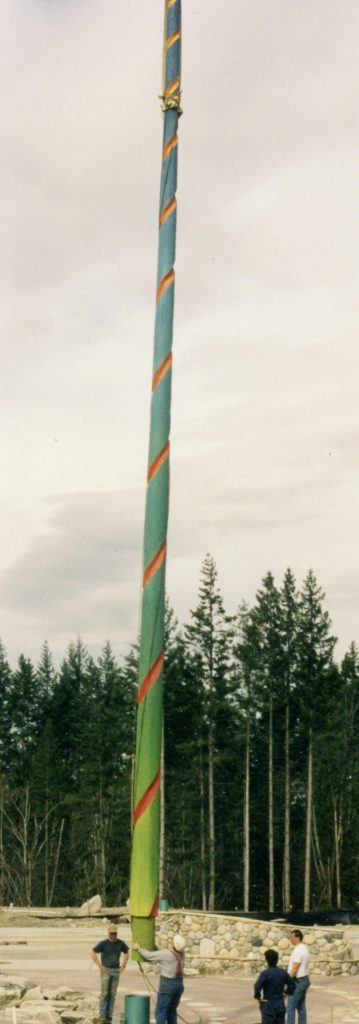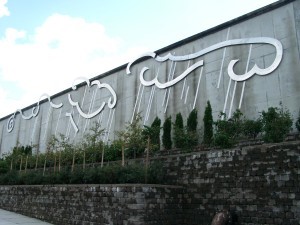
Twenty years ago, when Issaquah Highlands was still in its conceptual stage, a prominent visionary and self-described “recovering artist”, Milenko Matanovic, was introduced to the CEO of Port Blakely Communities, Judd Kirk. Milenko became an integral part of the planning of this now vibrant and remarkable community, Issaquah Highlands. I had the pleasure of meeting with Milenko recently to learn more about his involvement with the planning of Issaquah Highlands and his marvelous contributions to this community.
Milenko, a native of Slovenia and former member of the celebrated group OHO, turned his focus toward the collaboration connecting art with community building. As Milenko puts it, “When it comes to community, together we always know more.” In 1986 he founded the Pomegranate Center, headquartered in downtown Issaquah, believing that magic happens when art, creative thinking, and community join forces. Milenko’s designs characteristically incorporate the elements of public art into centrally located gathering places. This can be seen in many of his projects throughout cities in the U.S. and abroad.
 As his vision coincided naturally with the philosophies of Port Blakely, Milenko was instrumental in the development of the Issaquah Highlands Guiding Principles. These were built around concepts such as sustainability, environmental stewardship, community building and values that encouraged mixed use residential hubs and gathering places within the residential neighborhoods.
As his vision coincided naturally with the philosophies of Port Blakely, Milenko was instrumental in the development of the Issaquah Highlands Guiding Principles. These were built around concepts such as sustainability, environmental stewardship, community building and values that encouraged mixed use residential hubs and gathering places within the residential neighborhoods. 
With these principles in mind, Milenko developed the design of the first park to be built in Issaquah Highlands, Ashland Park. Ashland Park encompasses elements creating a gathering place for the new community. At the time of its construction, it was in a central location for the area. The center point of the park, marked by the 65’ cedar pole, is exactly where the four surrounding roads converged. At the base of the pole is a stage that faces a naturally sloped, grassy amphitheater. At the top of the amphitheater is a stairway that leads to a woonerf, or “living street”, designed for pedestrian traffic to be funneled into the park. The stage is backed by a large beautiful boulder, salvaged from nearby construction and turned into a charismatic fountain. Water runs down the rock and through a stream bed and forms a pond behind the stage. A cement semicircle backs the stage and fountain area. Surrounding the park are magnificent natural seating walls made of river rocks, many recovered from the park site itself. Ambient light, illuminating from carved light posts made from cedar trees reclaimed from the site, lights the parameter of the park at night. Also featured is a playground with wooden benches made from repurposed trees.
When asked how he thinks parks need to change over time, he responded, “They need to be aesthetic.” Relating to this concept and to introduce more elements of art to the park, the center pole and light posts were carved with spiral grooves and painted with either a blue to green variegation depicting the sky to grass or a yellow to red symbolizing the sun and earth. The spiral effect is carried out in the landscape with twelve flagstone pathways embedded in the cement and grass circling out from the pole. A colorful orange stain used on the cement added to the dynamism of the park.
As time passes, the park has weathered with faded paint, cracked cement, missing stones and a broken fountain. Several ideas were being considered vis-à-vis supplanting the park but since it is laden with significant history and meaning for Issaquah Highlands, the park will be restored this summer to reawaken the vibrancy of its original splendor and purpose. The fountain will be restored, the cedar poles repaired and painted and the stones replaced. Milenko will aide in the renovation to ensure the elements remain intact and the beauty of the park restored to its proper glory.
Other locations in Issaquah Highlands are also adorned with Milenko’s art designs. The imposing water tower along Park Drive is embellished with his brushed ‘wisps’ of reflective steel depicting clouds and rain. And the side of the building that currently houses the IHCA offices is decorated with the same reflective steel symbolizing the glacial melt flow.
This community is unquestionably privileged to have the influence of this talented and insightful visionary and we look forward to rejuvenating one of his most significant contributions to Issaquah Highlands.






